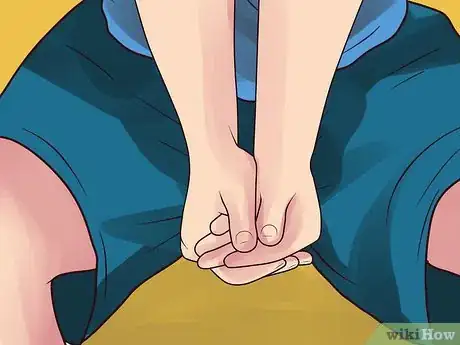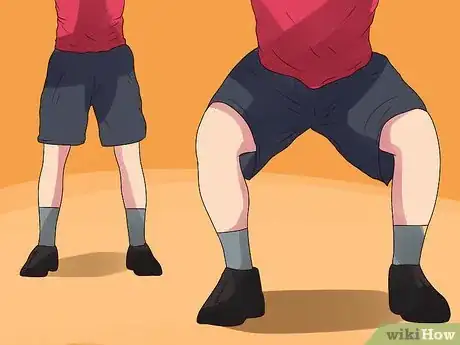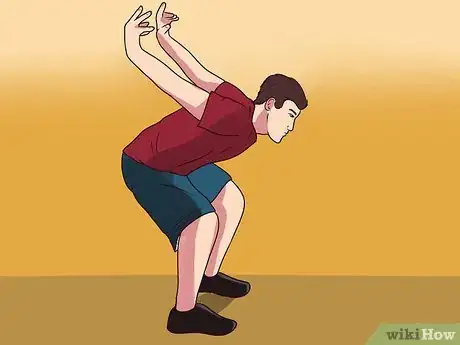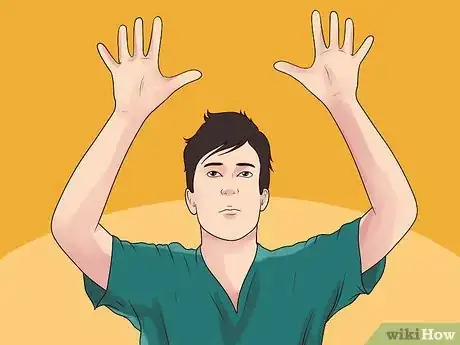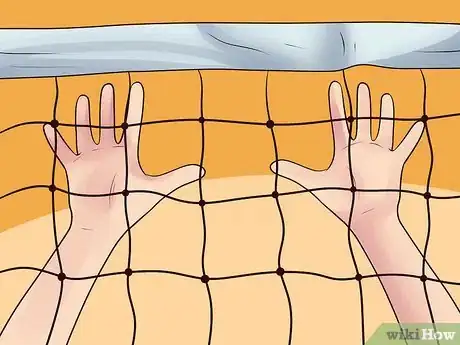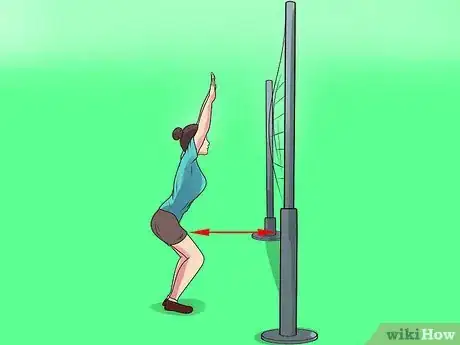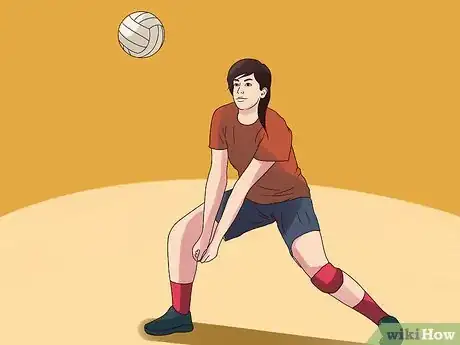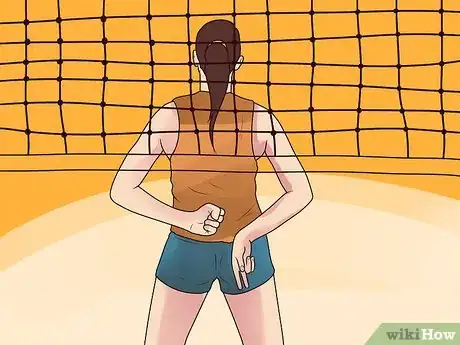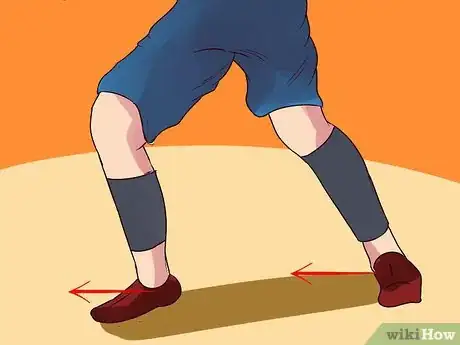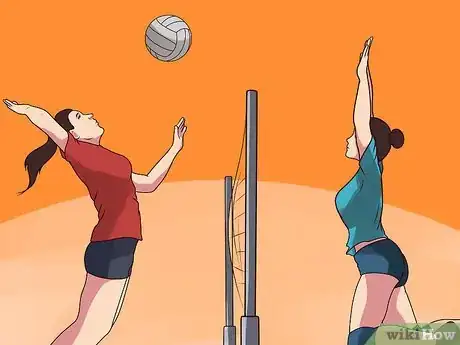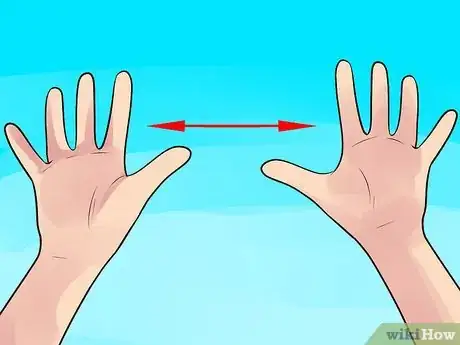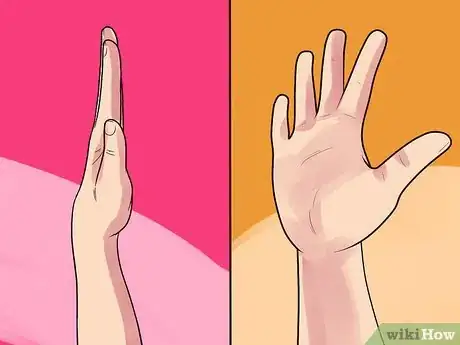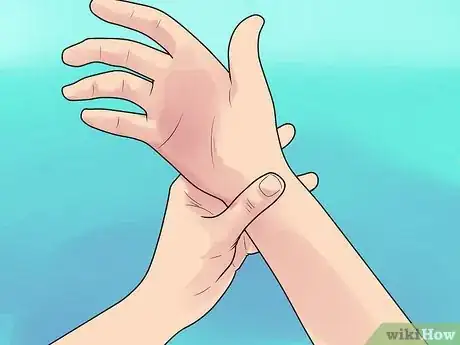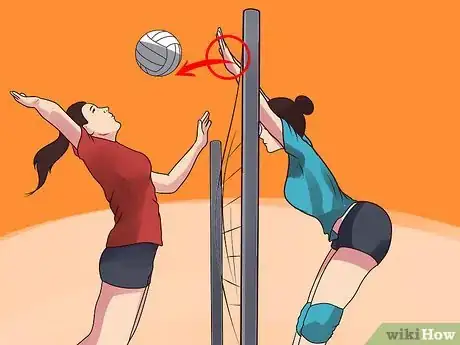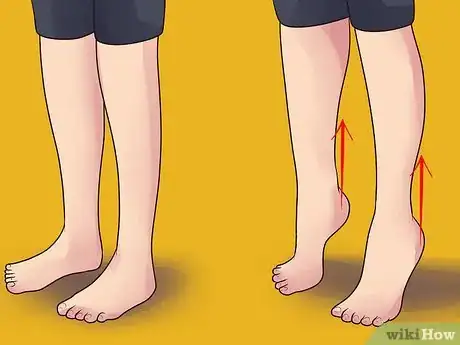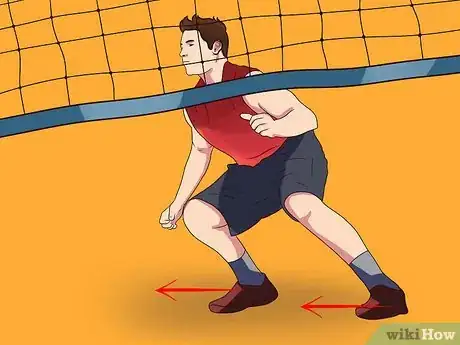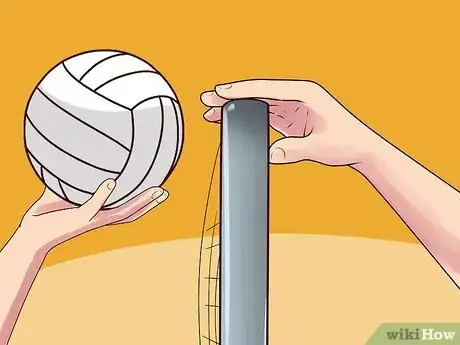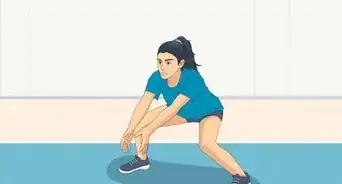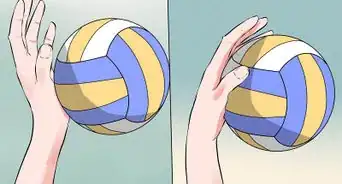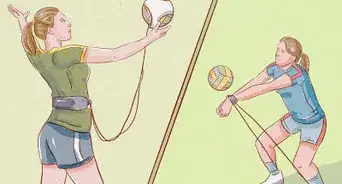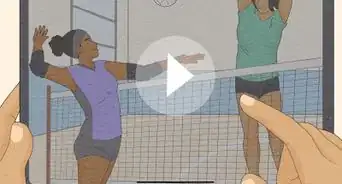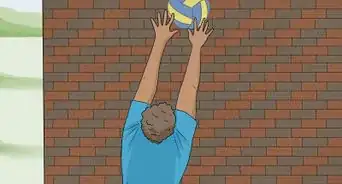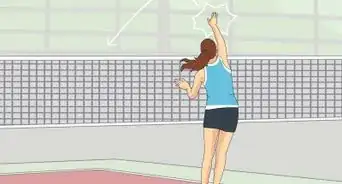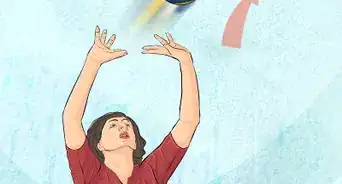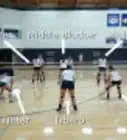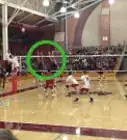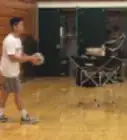wikiHow is a “wiki,” similar to Wikipedia, which means that many of our articles are co-written by multiple authors. To create this article, 13 people, some anonymous, worked to edit and improve it over time.
This article has been viewed 174,994 times.
Learn more...
Blocking in volleyball is one of the least taught yet most important skills. It is the first line of defense against attacks from the opposing team and creates less court for the back defense to cover. By following a few steps you can become a great blocker in volleyball.
Steps
Getting into the Ready Position
-
1Be ready at all times. Timing is one of the most important aspects in blocking; a fraction of a second could be the difference between stuffing an opponent’s attack and missing the ball completely. Being in the ready position will allow you to move more efficiently when attempting a block.[1]
-
2Stand with your feet shoulder-length apart square to the net. Keeping your feet the proper distance apart will help with your footwork, another essential aspect of blocking. With your shoulders and hips square to the net you will be able to jump straight up more quickly.[2]Advertisement
-
3Keep your knees bent. Keeping your knees bent is an essential part of the ready position. By keeping your knees bent you are ready to jump immediately rather than having to lower yourself and then jump up for the block. Be careful not to get lazy and stand straight up while waiting to block.
-
4Keep your arms high. Keep your arms high with your elbows around shoulder height. This also reduces the time it takes to get your arms up for the block. If they begin by your sides then they have much farther to travel to get high in the air.
-
5Keep your palms facing the net. This puts them at the correct angle for blocking and again reduces the time needed to get your hands in position, making you a faster blocker.[3]
-
6Stay a half arm’s length away from the net. If you touch the net while attempting to block you will get a violation. Allow sufficient space between your body and the net to ensure you do not accidentally touch it.
Using Proper Technique
-
1Learn proper timing. Watch the ball before it reaches the setter and then watch the setter. After watching the setter follow the ball and watch the hitter. Watching the entire sequence rather than just the hitter or the ball will help you prepare the best block.
- Watch the setter for a number of clues. If the pass to the setter is in a particular position or angle then it might limit the setter’s options for the set. You can also watch where the setter’s shoulders are angled or where he/she is looking to see where they plan to set the ball.
- Watch the ball right after the set to help you strategize your block. If the ball is far from the net after the set then the hitter probably cannot hit straight down and will take longer to get into position. You will need to delay your jump slightly and reach high to block the shot. If the set is close to the net then you should get maximum penetration on your block attempt. If the set is very low then you will need to be quicker to jump for the block because they will hit the ball quicker.
- Watch the hitter for different clues. Watch his angle of approach to see where you should line up when getting ready to block. If the hitter’s shoulders and upper body rotate then they may be preparing to hit across their body. If their shoulder or elbow drops then they may be preparing for a shot.
- Jump right when the hitter is making contact with the ball. You may have to adjust a little depending on the ball position and particular hitter.
-
2Communicate with your teammates. Most teams will designate one person (usually the middle blocker) as the blocking captain to aid in communication regarding blocking. They will coordinate the other blockers to prepare the best blocking strategy.
- It is important to watch the hitters and the setter as these are the people to whom your defense will need to react when attempting to block.
- It is helpful for the blockers to call out the setter location and who the hitters are before the serve to prepare your team for defense.
-
3Use proper footwork. It is important to move quickly on your feet in order to get your body in front of the hitter’s hitting shoulder to make the block. There are two footwork patterns that can be used to quickly get to the correct position: the sidestep and the crossover step.
- The sidestep is used when the hitter is within 3–5 feet (0.91–1.5 m) of you. Take one step with the foot closest to the hitter and then follow with the other foot so they are shoulder-width apart once again. Keep your hips and shoulders square to the net as you sidestep. If it takes you more than two steps to reach the hitter then you should rather use the crossover step.
- The crossover step is used when you need to cover more ground, for example if the hitter is more than 5 feet (1.5 m) (1.5m) away from you. Step first with the leg closest to the hitter and then cross the other leg in front of your body. Although your hips may angle towards the hitter during the cross step, your shoulders should remain square to the net. Step again with the foot closest to the hitter to bring your feet back to shoulder-width apart and make your hips square to the net once more.
-
4Jump straight up. Get yourself directly in front of the hitter shoulder of the hitter and jump straight up to attempt a block. Make sure you are balanced before jumping and jump at the same time as the hitter makes contact with the ball.
-
5Angle your hands inwards as if you are grabbing the ball. Your hands should be close together (about 4-6 inches or 10-15cm between them) and angled inwards while blocking. This will direct the block back down into the opponents’ court and reduce the chances of deflection away from your other defenders. Keeping your hands together prevents the ball from going in between them.
- You do not want your hands to form a flat surface or else the ball can deflect in many different directions off of them.
- If you are close to the edge of the court, angle your outside arm and hand inwards so that if you deflect a shot it will go into the court rather than outside the lines.
- If you are a shorter player and cannot penetrate to the other side or cannot penetrate for another reason, keep your hands angled backwards. This is attempting to slow down the ball through touches for your defenders rather than block it.
-
6Keep your fingers spread wide and relaxed but straight. Keeping them spread out makes a bigger surface area for the ball to touch and makes your fingers slightly softer so major deflections don’t occur. Big deflections might make it difficult for your other defenders to get to the ball.
- Keeping your fingers tight, flexed and rigid will make it impossible to direct the ball. Often times the ball will bounce outside the court even if it is blocked. You want them to be straight and strong without being overly rigid.
-
7Keep your wrists rigid. You will need to keep your wrists rigid to work against a hard spike. Be careful about your wrists as they can become sore or injured if you do not keep them rigid.
-
8Position your arms at an angle over the net. Arms should be straight and go over the net as far as possible. This will get you closer to the ball. Even though you lose a little bit of height with this technique, it is more important to penetrate to the other side of the court than to have additional height. This way the ball will deflect back into the opponents court rather than in another direction.
- Make sure when you do this that you do not thrust your hips forward. Rather your upper body should be angled forward with your abs tight to pull your upper body towards the hitter.
- If you are a smaller blocker you should rather keep your arms straight up with your fingers angled slightly backwards. This also works if you are late and cannot penetrate to the other side.
Training for Blocking
-
1Work on your jumping skills. Height, arm length and jumping ability can greatly help one to block in volleyball. You cannot change your height but you can train your jumping ability, for example by doing squats, calf rises or strength training. Train yourself to jump at your maximum height to enhance your jumping ability.
-
2Practice your footwork. Quick feet are an essential aspect of any blocker. Plays can happen very fast and include decoys to distract you. Practice your sidestep and crossover step.
- The sidestep is used when the hitter is close. Take one step with the foot closest to the hitter and then follow with the other foot so they are shoulder-width apart once again. Keep your hips and shoulders square to the net as you sidestep. Practice this step sideways back and forth in front of the net, keeping your feet as light and fast as possible.
- The crossover step is used when you need to cover more ground. Step first with the leg closest to the hitter and then cross the other leg in front of your body. Although your hips may angle towards the hitter during the cross step, your shoulders should remain square to the net. Step again with the foot closest to the hitter to bring your feet back to shoulder-width apart and make your hips square to the net once more. Practice this step sideways back and forth in front of the net, keeping your feet as light and fast as possible.
-
3Practice hand and arm position drills. Have an assistant hold the ball up on the opposite side of the net. Jump and catch the ball and bring it back to your side. Your hands and arms should be bent over the net but not touching the net. This practices proper hand and arm position for the block. .
- The ball should be as far as possible on the other side to help you train your skills.
- You should never keep your arms straight up when blocking but rather bend them slightly forward over the net. This exercise will mimic proper technique when blocking.
- The hands should be next to each other when grabbing the ball, which is proper technique when blocking.
- To advance the training the assistant should move the ball to the right and left to help you practice blocking different kind of shots such as angle shots and line shots.
Community Q&A
-
QuestionHow should I angle my hands if I want to fully stop the ball and hit it back down to the other side rather than deflect it?
 Community AnswerAngle them towards the court. Those shots are easier to stop, though, so you might not want to do that.
Community AnswerAngle them towards the court. Those shots are easier to stop, though, so you might not want to do that. -
QuestionWhat are some ways to train and improve your jump?
 Community AnswerBuild strength in your legs and core to improve your jump, and practice launching yourself up as high as you can from the ground.
Community AnswerBuild strength in your legs and core to improve your jump, and practice launching yourself up as high as you can from the ground. -
QuestionHow do you dive for a volleyball?
 Community AnswerLooking carefully at the ball, keep your arms straight out and dive, trying to land on your knees and stomach. Then slide with arms together and extended towards where you think the ball will land. Then get back into position as quickly as you can.
Community AnswerLooking carefully at the ball, keep your arms straight out and dive, trying to land on your knees and stomach. Then slide with arms together and extended towards where you think the ball will land. Then get back into position as quickly as you can.
Warnings
- Be careful not to touch the net when blocking. If the referee sees you touch the net he'll give the point to the opposing team.⧼thumbs_response⧽
- Always jump with two feet and land with two feet so that you don't injure yourself and to prevent drifting while in the air.⧼thumbs_response⧽
References
About This Article
To block in volleyball, stand with your feet shoulder-width apart, with your hips square to the net and your knees slightly bent. This will keep you ready to jump at all times. Keep your arms high with your palms facing the net, but stay at least a half arm’s length away from the net to avoid getting a penalty. When the other team has the ball, watch their moves carefully and try to anticipate when the ball will come your way. When it does, jump straight up, with your fingers spread wide and your wrists rigid. Position your arms at an angle over the net and hit the ball back to the other side. To learn more about the footwork needed for blocking, read on!
